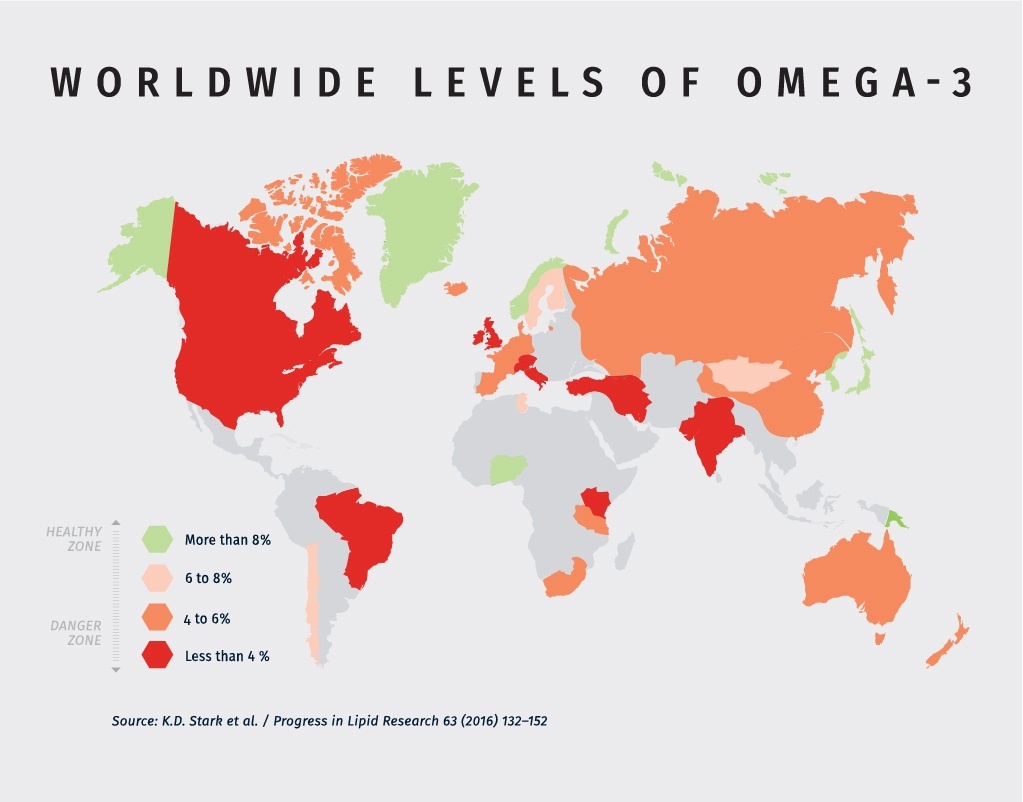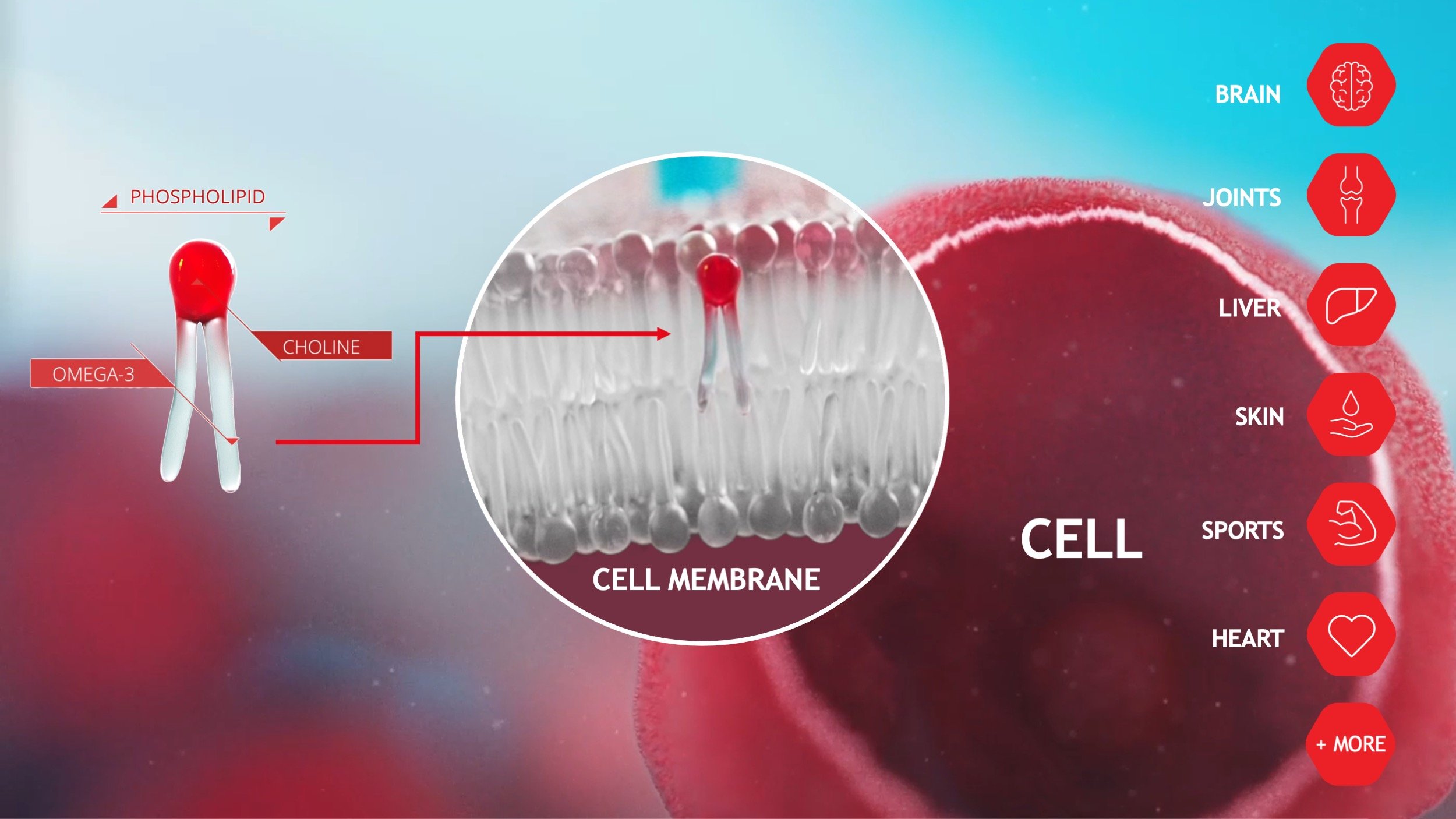Our modern diets have led to excess amounts of omega-6 in our bodies, largely believed to impact inflammation levels and triggering diverse negative health outcomes . One remedy is to boost intake of omega-3s EPA and DHA to create balance and improve health.
A common challenge with our modern lifestyle is maintaining a healthy level of inflammation in the body. Some amount of inflammation is necessary, to fight off infection and help the blood clot for example, but too much inflammation can lead to increased strain on our organs such as the heart and joints.
At the root of this bodily battle of inflammation versus anti-inflammation are the essential fatty acids: omega-6s and omega-3s. Our bodies don’t produce these fatty acids naturally, so we must consume them through food. And while both types are considered “essential”, they play differing roles in terms of their effects. Omega-6s are pro-inflammatory, while omega-3s are anti-inflammatory. A healthy balance of both is ideal.
Today’s modern western diet has led to an imbalance in the omega-6 to omega-3 ratio.
During pre-industrial times, when lifestyle health issues were less common, the average human consumed far fewer processed and ultra-processed foods (think processed vegetable oils and corn/grain fed raised animals). The typical western diet today is much higher in these types of oils and conventionally raised meats. At the same time, we see that the vast majority of the world’s population have low intakes of Omega-3s EPA and DHA.
See map below for the worldwide levels of omega-3:

Scientific studies show that the omega-6 to omega-3 ratio for humans consuming western diets is around 16 to 1 at present – a stark contrast to the human evolutionary ratio of about 4 to 1. One of the primary perpetrators of our excess omega-6 levels is soybean oil. Soybean oil is commonly found in highly process foods, and in the U.S. alone, the population has seen a dramatic increase in the amount of soybean oil consumed. In fact, between 1960 to 2010, the U.S. population saw a 200% increase in omega-6 fatty acids!
Due to this influx of processed oils, studies show that people in the U.S. have built up excessive amounts of omega-6 in their bodies, both in their body fat stores and cell membranes, negatively impacting the body’s inflammation levels. This imbalance is believed to have served as a catalyst for the growing occurrence of many prevalent and chronic diseases, as we are simply not getting enough omega-3s naturally from our food anymore.
The importance of omega-3 for cell membrane functionality
The food you eat provides the raw material substrate that is then assembled into the cellular membranes, which is why the type of fats you consume is so important.
Omega-3s have a variety of different functions in the body, which tend to occur mostly at the cell level. They are first and foremost a structural component of our cell membranes and help the membrane to remain flexible so our body’s cells can do their job efficiently.

When scientists investigate the effects of omega-3 on human health, they typically look at something called the omega-3 index. This is a measure of the omega-3 levels of EPA and DHA in the red blood cell membrane. The omega-3 index is an actual test you can take to assess your omega-3 status and can serve as a risk factor for heart health.
A beneficial omega-3 index would be around 8 percent or higher. Today, most of the world’s population have an omega-3 index of about 4%.

There has been extensive research into the benefits of omega-3 for decades, in fact, omega-3s are one of the most studied nutrients in history. *Already back in 2009, scientists reported (in PLOS Medicine) that low levels of omega-3 in the body contributed to 84,000 deaths per year in the United States alone. The study authors said that low levels of omega-3 were on par with high levels of trans fats in the diet when it came to the mortality effect of each.
Omega-3 has been under the microscope ever since, as researchers seek to understand its full health potential. The Framingham Heart study concluded that a higher Omega-3 Index was associated with reduced risk of both CVD and all cause mortality. A review article from 2022 published in Nature concludes that higher circulating levels of marine n-3 PUFA are associated with a lower risk of premature death and also note that higher cellular levels of the LC n-3 PUFAs appear to slow the aging process.
These are just some examples, but what scientists tend to conclude in general for omega-3s is that omega-3 has lifelong health benefits, and when high omega-3 index levels are optimally maintained, we may in fact live healthier for longer.
Omega-3 supplements can enhance your body’s fatty acid balance.
While removing certain processed oils from the diet is feasible, it can be difficult to avoid the ingestion of all omega-6s, nor should you. The best way to achieve an optimal omega-3 index is through marine-based sources, which is what delivers the long chain omega-3s EPA, DPA and DHA to the body. These are the fatty acids that possess the much sought after mortality-reducing health benefits. But getting back to a balanced state can be challenging for those who aren’t consuming high amounts of seafood during the average week. To get the right amount of omega-3 back in your body, a daily supplement can be a good alternative.
By increasing your omega-3 intake, the EPA and DHA can help to push the omega-6 out of your membranes.
Marine sources of omega-3, and especially krill-based omega-3 supplements, have long been known as especially effective in increasing the omega 3 levels in the body.
Absorb higher amounts of omega-3 with krill phospholipids.
Krill omega-3s have a unique advantage that most other sources of omega-3 simply don’t: phospholipids. The omega-3s from krill are bound to phospholipids, while omega-3s from fish oil are bound to triglycerides. Since phospholipids are a natural part of the human cell membranes, the cell membrane absorbs it efficiently positively impacting cells, organs and whole body health.
Science has proven time and time again that Krill oil phospholipids efficiently increase the omega-3 index in the body (1,2,3,4). Increasing the omega-3 index in the red cell membrane automatically improves the balance of the omega-6 to omega-3 ratio in a beneficial manner, contributing to overall improved health.
One easy step to improving your health is to lower the intake of omega-6s and boost the intake of omega-3s. Doing this successfully comes down to awareness and making the right decisions to improve your body’s fatty acid balance. Krill omega-3s are a good nutritional choice on the road to a better omega-6 to 3 ratio – packing a powerful nutritional punch with every phospholipid-packed supplement taken.
Read more about how to optimize your omega-3 levels here in this brochure
References:
2) Drobnic 2021: Krill-Oil-Dependent Increases in HS-Omega-3 Index, Plasma Choline and Antioxidant Capacity in Well-Conditioned Power Training Athletes
3) Alkhedhairi 2022: The effect of krill oil supplementation on skeletal muscle function and size in older adults: A randomised controlled trial
4) Stonehouse 2022: Krill oil improved osteoarthritic knee pain in adults with mild to moderate knee osteoarthritis: a 6-month multicenter, randomized, double-blind, placebo-controlled trial

